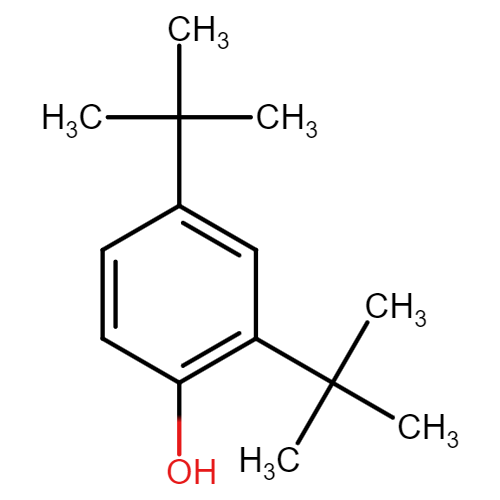2,4-Di-tert-butylphenol
| Compound Structure: |

|
||||||||||||||||||||||||||||||||||||||||||||||||
|---|---|---|---|---|---|---|---|---|---|---|---|---|---|---|---|---|---|---|---|---|---|---|---|---|---|---|---|---|---|---|---|---|---|---|---|---|---|---|---|---|---|---|---|---|---|---|---|---|---|
| Synonyms: | 2,4-Di-tert-butylphenol;96-76-4;Antioxidant No. 33;2,4-DI-T-BUTYLPHENOL;1-Hydroxy-2,4-di-tert-butylbenzene;Phenol, 2,4-bis(1,1-dimethylethyl)-;Phenol, 2,4-di-tert-butyl-;2,4-bis(tert-butyl)phenol | ||||||||||||||||||||||||||||||||||||||||||||||||
| Compound ID: | NMPC-182 | ||||||||||||||||||||||||||||||||||||||||||||||||
| PubChem ID: | |||||||||||||||||||||||||||||||||||||||||||||||||
| Molecular Formula: | C14H22O | ||||||||||||||||||||||||||||||||||||||||||||||||
| Canonical SMILES: | CC(C)(C)C1=CC(=C(C=C1)O)C(C)(C)C | ||||||||||||||||||||||||||||||||||||||||||||||||
| InChIKey: | ICKWICRCANNIBI-UHFFFAOYSA-N | ||||||||||||||||||||||||||||||||||||||||||||||||
| About the compound: | 2,4-Di-tert-butylphenol is a chemical compound belonging to the class of phenols, and it has two tert-butyl (or 2-methyl-2-propanol) groups attached to the phenol ring at positions 2 and 4. This compound is of interest for its antioxidant properties and is found as a natural product in various organisms, including bacteria like Bacillus subtilis and Streptomyces parvulus. Antioxidants like 2,4-di-tert-butylphenol are important in various industries for their ability to inhibit the oxidation of other compounds and to help extend the shelf life of products. GHS Hazard Statements • H302 (37.26%): Harmful if swallowed [Warning Acute toxicity, oral] • H315 (89.23%): Causes skin irritation [Warning Skin corrosion/irritation] • H318 (46.15%): Causes serious eye damage [Danger Serious eye damage/eye irritation] • H319 (43.08%): Causes serious eye irritation [Warning Serious eye damage/eye irritation] • H335 (52.65%): May cause respiratory irritation [Warning Specific target organ toxicity, single exposure; Respiratory tract irritation] • H373 (10.94%): Causes damage to organs through prolonged or repeated exposure [Warning Specific target organ toxicity, repeated exposure] • H400 (57.95%): Very toxic to aquatic life [Warning Hazardous to the aquatic environment, acute hazard] • H410 (65.9%): Very toxic to aquatic life with long lasting effects [Warning Hazardous to the aquatic environment, long-term hazard] |
||||||||||||||||||||||||||||||||||||||||||||||||
| Properties: |
Chemical and Physical Properties
Source: PubChem |
||||||||||||||||||||||||||||||||||||||||||||||||
| Source Species: |
Artocarpus altilis. Crateva adansonii Urena lobata Parkia biglobosa |